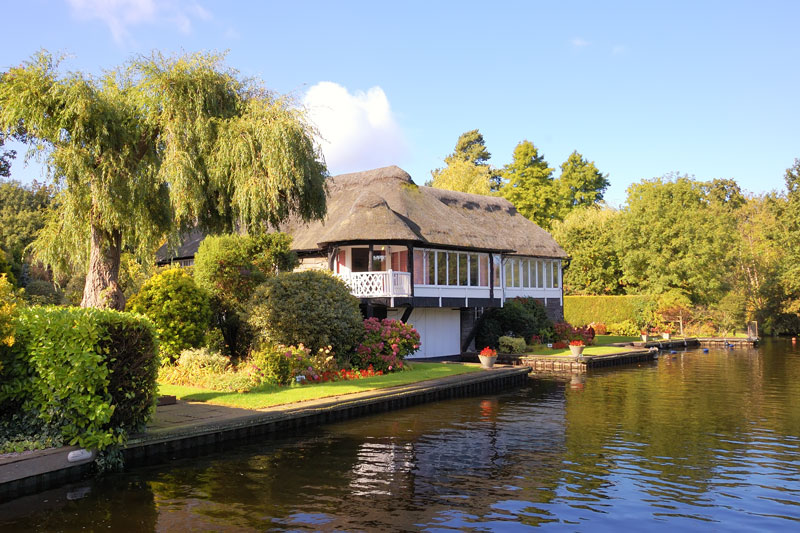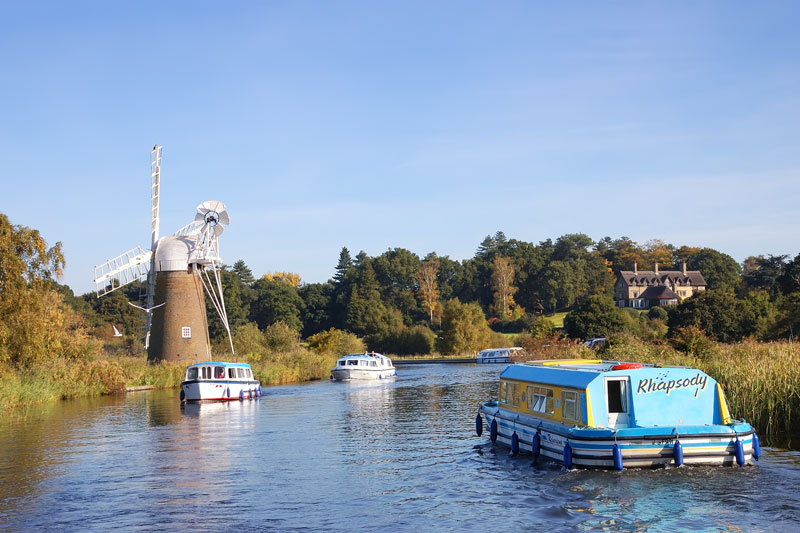River Ant – Irstead to Ant Mouth
The river narrows on entering Irstead, the river bed here is gravel hence the name The Shoals. Slow down and admire the picturesque thatched cottages.
On the right is Irstead Staithe.

Irstead

Irstead staithe is small and offers no facilities other than refuse disposal, but the village and in particular the reed thatched church of St Michael is worth visiting. A number of very attractive thatched cottages are at the waters edge, slow down as you pass through this narrow section.
The river meanders south through Hall Fen and Reedham Marsh, there are some lovely spots suitable for mooring , but look out for underwater obstructions. The river has a very rural, less sophisticated feel as it winds it’s way towards How Hill. Bundles of thatch may be seen at the waters edge waiting for collection.
On the left bank is the entrance to Crome’s Broad, mooring is available at the mouth of the small dyke but the broad is not open to navigation.
A little way downstream, on the How Hill Nature reserve is Clayrack Drainage Mill. It is a hollow post mill with a full set of sails which drive a scoop wheel, it was originally sited on Ranworth Marshes. The sails have been removed for restoration (2016). Situated 200 metres downstream is Boardman’s Drainage Mill , an open framed timber trestle mill with miniature cap, sails fantail and turbine. Extensive moorings are available on the left bank at How Hill Staithe
How Hill Nature Reserve

How Hill has been called a “microcosm of Broadland habitat” and indeed it is –
Look out for the stacks of reed at the staithe waiting to be collected to make someone a new roof. An environmentally friendly Edwardian style electric boat, the Electric Eel, takes up to 8 people on a 50 minute journey along clear dykes through the reeds and fens of the How Hill estate. The boat leaves from the staithe, on board the experienced guide relates to you the story of the Broads and how marshmen worked in days gone by.
A small marshmans cottage Toad Hole gives the visitor an idea of Victorian life on the Broads. Eric Edward’s was the marshman at How Hill, he was often seen working in the reed beds or giving demonstrations at the staithe. Eric sadly passed away on the 24th May 2012.
How Hill House, is the home of the How Hill Trust. There are two separate gardens at How Hill, near the house are the formal Edwardian gardens with their famous Yew Hedges and extensive views over the marshes. Hidden away in the woods are the unique bog gardens, dominated in late Spring by Azaleas and Rhododendrons. For visitor information check out the How Hill Trust website.
On the right bank, opposite How Hill Staithe is Turf Fen Windpump .
From here to just before Ludham bridge mooring is dangerous due to submerged stakes. The river now makes a wide horseshoe bend as it heads towards Ludham Bridge, the banks become more open and the water can get choppy in the breeze.
Ludham Bridge
At Ludham Bridge there are good moorings on both sides of the river before the bridge, 8 ft 6 in headroom at average high tide, with a water point on the Ludham side. It can be very windy here. Ludham Bridge Stores stock a good range of provisions and also hire cycles. A Public Telephone is near the bridge. The Dog Inn is a 5 minute walk towards Ludham village and is listed in the Good Pub Guide. Under the bridge on the left is Ludham Bridge Boatyard. On the right a little past the boatyard moorings are available (fee).
On passing through the bridge the river takes a sharp turn to the left, look out for craft manoeuvring for the bridge. The next ¾ of a mile to Ant Mouth is uneventful, slow down as the Bure is reached and be prepared to give way.
